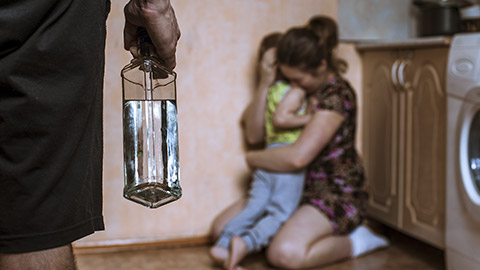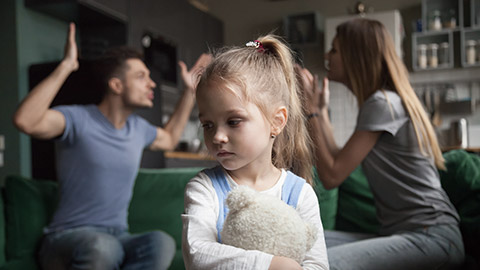This unit describes the skills and knowledge needed to identify and respond to the needs of clients who may be experiencing domestic and family violence, including responding to immediate intervention and support needs.
This unit applies to health and community support workers providing services according to established organisation procedures. These workers may not be specialised family violence workers. The skills in this unit must be applied in accordance with Commonwealth and state/territory legislation, Australian/ New Zealand Standards and industry codes of practice.
Trigger Warning
This unit contains materials and topics that some may find distressing and confronting. If you find that you are affected, please discuss this with your trainer, who may be able to refer you to support and resources within your training organisation or within your local community.
You may also wish to explore online resources and supports such as:
1800RESPECT
A list of helplines from White Ribbon Australia
‘Domestic and Family Violence’ from Lifeline
A list of support services from the Australian Government Department of Social Services
A list of Australia-wide services from the Domestic Violence Resource Centre Victoria
Domestic and family violence is also called domestic violence, family violence, relationship violence, intimate partner violence, domestic abuse,
and child abuse.
Workers across all sectors of health and community services are likely to encounter clients affected by domestic and family violence, so it is important for you to understand what this is and how to respond appropriately.
By the end of this topic, you will understand:
- How domestic and family violence is defined
- How prevalent it is within contemporary Australian society
- The social, political, legal and economic context of domestic violence
- The types and nature of domestic violence
- Power and gender issues in relation to domestic violence
- Child abuse in relation to domestic violence
- Criminal issues associated with domestic violence
- The impact of domestic and family violence
- Some of the common myths and incorrect beliefs about domestic violence
Domestic and family violence (DFV) is violence that occurs within an intimate or family relationship, which is often based on a significant imbalance of power. It includes physical, sexual, emotional, financial and economic abuse and psychological violence or threats. It occurs across all sections of our society and is a major social issue in Australia.
Domestic and family violence is also called domestic violence, family violence, relationship violence, intimate partner violence, domestic abuse, and child abuse.
Domestic and family violence is a serious problem. Australian police deal with 5,000 domestic and family violence incidents on average every week – one every two minutes.
Those who experience it often do so over long periods, sometimes decades. The suffering they experience can be intense, and the effects long-lasting.
DVA Family and Domestic Violence Strategy 2020
Reading
To learn more about the definition of domestic and family violence, visit the following links:
- ‘Domestic Violence in Australia: Definition, Prevalence and Nature of Presentation in Clinical Practice’ from the Medical Journal of Australia
- ‘Domestic Violence and What You Can Do About It’ from ReachOut

Domestic and family violence can affect anybody. It occurs across all sections of our society and is not restricted by class, age, gender or culture. Those most affected are women and children.
The majority of people who experience family and domestic violence are women in their home. One in four Australian women had experienced violence by an intimate partner since the age of 15, according to the 2016 Australian Bureau of Statistics Personal Safety Survey.
Domestic and Family Violence Statistics
Domestic and family violence in Australia:
- 16% of women (1.5 million) and 5.9% of men (528,800) have experienced physical violence from a partner since they were 15.
- More than 1 million Australian children are affected by domestic and family violence.
- Around 37% of people seeking help from specialist homelessness services in 2018- 19 were experiencing domestic and family violence.
- Domestic and family violence was the main reason why 80,000 people asked for help from specialist homelessness services in 2018-19.
- Of the people who asked for help from specialist homelessness services due to domestic and family violence-related issues, more than three out of four, or 77%, were female.
- On average, one woman per week is killed by a current or former partner.
- On average, one male per month is killed by a current or former partner.
(Mission Australia)
Vulnerable Groups
While anyone can be affected by domestic and family violence, there are some groups that may be more vulnerable than others and are represented more frequently in the statistics, including:
- Women
- Children and young people
- People with children
- Old people
- People with disability
- People from culturally and linguistically diverse backgrounds (CALD)
- Aboriginal and Torres Strait Islander People
- People living in regional, rural and remote communities
- People affected by substance misuse
- People who are lesbian, gay, bisexual, transgender, queer and intersex (LGBTQI)
- People with poor literacy skills
Reading
Read about family, domestic and sexual violence in Australia at the following link:
‘Family, Domestic and Sexual Violence in Australia: Continuing the National Story 2019’ from the Australian Institute of Health and Welfare

There are many factors that influence the occurrence of domestic and family violence in our society today. Understanding these factors can help us to understand, recognise and respond appropriately.
The issue of domestic and family violence in Australia is deeply intertwined with various social, historical, political, and economic contexts. Understanding these contexts is crucial for comprehending the multifaceted nature of domestic violence and the challenges involved in addressing it effectively. This analysis explores how these different contexts contribute to the perpetuation, perception, and handling of domestic violence in Australia, providing a comprehensive overview of the underlying factors that shape this critical social issue.
Social Context: Societal norms, gender stereotypes, and expectations can foster power imbalances, creating an environment where abusive behaviours thrive. Social stigma may deter victims from reporting incidents, perpetuating the cycle of abuse.
Historical Context: Historically, domestic violence was considered a private matter. Shifts in societal awareness, especially since the 1970s women's liberation movement, led to legislative changes recognizing domestic violence as a criminal offense.
Political Context: Political contexts involve policy development, funding, and legislative frameworks. Australia has national plans, awareness campaigns, and support service funding. Political debates may impact prioritization and resource allocation.
Economic Context: Economic dependence heightens vulnerability, stressing courts and services. Survivors often rely on Centrelink for financial aid, highlighting the need for comprehensive support systems.
lets look at these in more detail now:
History
Domestic and family violence has probably existed for as long as the human family unit has existed. Within any close relationship, there is potential for power imbalances, conflict and abuse.
In relatively recent times in Western European cultures and societies, women have been regarded in law as anything other than the property of their male relatives. For example, in 1866 in Britain, a wife and all her property belonged to her husband by law. It was not until 1925 that women were allowed to inherit and own property in their own right. Until 1891, husbands were allowed to use force and corporal punishment to control their wives and children.
Case Study
Read this timeline of women's rights and their money to understand the context of women being seen as equal in society.
Women's rights and their money: a timeline from Cleopatra to Lilly Ledbetter
After reading this article, answer the following questions.
Watch
Watch the following video to gain an insight and understanding into how our own personal history can play a part in how we understand gender roles.
Reading
Read the following articles to learn more about the history of domestic violence:
- 'Domestic Violence, Past and Present’ from the Journal of Women’s History
- ‘Domestic Violence Has a History: Early Modern Family Violence’ from the Australian Women’s History Network
- 'The Long History of Gender Violence in Australia, and Why It Matters Today’ from The Conversation
Legislative and Policy Context
Laws
Apart from provisions in the Commonwealth Family Law Act 1975 relating to custody orders for children affected by domestic and family violence, there is no national, consistent legislation covering domestic and family violence within Australia. Instead, states/ territories are responsible for legislation in this area.
1.13. There is legislation in force in all Australian States and Territories, and in New Zealand, that empowers courts to make apprehended violence orders
specifically to protect victims of domestic violence or persons at risk of domestic violence.
1.14. The precise provision made by the legislation in these jurisdictions differs in myriad ways. Further, there is variation across jurisdictions in the basic approach taken to some important issues.
The National Council to Reduce Violence Against Women and Their Children
Despite these variations, there is a degree of consistency in what is counted as domestic violence, in the types of relationships that are covered, in the powers of police
to take immediate action, and in the legal actions and penalties that can be used to protect people affected by domestic and family violence through court orders restraining the perpetrator.
The following passage from the report Domestic Violence: Issues and Policy Challenges provides a clear overview of the distribution of responsibilities between Commonwealth and state/territory jurisdictions:
The Australian Government is responsible for the over-arching government programs designed to reduce domestic violence. Through its national initiatives, the Commonwealth sponsors state and territory government cooperation in the development and implementation of models for addressing and preventing this form of violence. However, the state and territory governments, not the Commonwealth Government, have the law enforcement responsibilities in relation to policing and prosecuting instances of domestic violence.
Although there are Australian Government funded programs operating in the states and territories, for example supported accommodation, each jurisdiction funds and administers its own programs and services aimed at preventing domestic violence and supporting those a昀昀ected through their community service/human services and health departments together with police and other agencies.
The cited report contains an excellent discussion of domestic violence issues and outlines a holistic, an integrated approach to domestic and family violence, including:
- Campaigns to raise awareness and prevent DFV
- Programs to provide education and support for perpetrators and people affected by DFV
- Legislative changes and the involvement of courts and the police in providing protection orders
- The creation of specialist domestic and family violence courts
You can read the Domestic Violence: Issues and Policy Challenges report: Domestic Violence: Issues and Policy Challenges from the Parliament of Australia.
Activity
Government Policies and Strategies
Australian Government services developed a strategy to address domestic and family violence in the next three years.
It defines domestic and family violence as including:
- verbal
- financial
- emotional
- psychological abuse (including through the use of technology such as social media)
- stalking
- threatening or causing injury, harm or death to the person or others, including family pets
- damaging property
- cultural or spiritual abuse.
The strategy statement promises to create environments where customers and staff feel comfortable asking for support, systems and processes are simple and safe, and work with the community to provide support is carried out.
Important
The following link provides an outline of the Family and Domestic Violence Strategy 2020–23:
- Family and Domestic Violence Strategy 2020–23 by the Australian Government Services
The National Plan
Another essential document is the National Plan to Reduce Violence Against Women and Their Children 2010–2022, which was developed by the Department of Social Services and explains how Commonwealth and state/territory governments will work together more effectively to increase support and bring about change. The strategic focus is on raising awareness and changing attitudes and behaviours, particularly building respectful relationships with future generations.

Domestic and family violence includes a wide range of behaviours ranging from belittling and undermining someone verbally to extreme physical violence that sometimes results in death.
This quote gives a clear, broad overview of what domestic and family violence is:
Domestic violence refers to violent behaviour between current or former intimate partners – typically where one partner tries to exert power and control over the other, usually through fear. It can include physical, sexual, emotional, social, verbal, spiritual and economic abuse. Family violence is a broader term that refers to violence between family members, which can include violence between current or former intimate partners, as well as acts of violence between a parent and a child, between siblings, and more.
Forms of Domestic Violence
The many different forms that domestic and family violence can take include these behaviours:
- Physical harm – threatening self/physical harm, hurting pets
- Property damage – breaking or damaging possessions and furniture
- Emotional and psychological abuse – humiliation, put-downs, blaming
- Financial abuse – strict or unfair control of money
- Verbal abuse – name-calling, yelling
- Social abuse – controlling where a person goes and who they see
- Sexual abuse – harassment, molestation, rape
- Stalking – following, making excessive phone calls, texts or emails
- Spiritual or cultural abuse – controlling practices or choices
The Common Element in Domestic Violence
Power and Gender Issues: Traditional gender roles and perceptions of entitlement reinforce power imbalances, making it easier for abusive behaviours to persist. Efforts to address domestic violence include challenging these gender norms and empowering victims to break free from oppressive dynamics, promoting equality and respect in relationships.
Child Abuse: Children witnessing or experiencing abuse can face long-term physical, emotional, and behavioural issues. The interconnection between domestic violence and child abuse requires a comprehensive approach to ensure the safety and well-being of children, including supportive interventions and therapeutic services.
Criminal Issues: Legal frameworks in Australia prosecute offenders and issue protection orders to ensure victim safety. Criminal behaviours associated with domestic violence, such as stalking, assaults, property damage, kidnapping, financial abuse, and murder, are punishable offences under these frameworks, reflecting the seriousness of these acts.
In summary, the use of power, control and intimidation is a common element in all of the different behaviours typical to DFV. Another feature is isolating the person from friends, family and social support, which increases the perpetrator’s control and increases the person’s dependence.
Some of these behaviours constitute criminal offences, for example, stalking, physical and sexual assaults, property damage, kidnapping or imprisonment, and some forms of financial abuse and murder.
Example
Recently, in Western Australia, non-fatal strangulation, which is a behaviour classified as domestic violence, has been recognised as a specific offence with the passing of the Family Violence Legislation Reform Bill, 2019. Read about the journey of classifying non-fatal strangulation as a specific offence at the following link:
‘The Long, Hard-Fought Journey With Non-Fatal Strangulation’ from the Australian Medical Association (WA)
Watch
This video shows a great representation of the different signs of abuse.

Research has shown that abusive relationships tend to follow a cyclic pattern. The nature of this cycle confuses and undermines the person against whom the violence is directed and keeps the person ‘hooked’ into the relationship, ever hopeful that things will improve. Typically, the perpetrator expresses remorse after each episode of violence and encourages the other person to feel guilt for somehow causing the violence. Over time the cycle grows shorter and the gaps between each phase grow shorter.
Impact, a charity dedicated to assisting women and children escaping domestic violence, has created the following graphic to illustrate the cycle of abuse.
Activity
Watch the following video: ‘Can you spot the red flags of domestic violence' on YouTube.
Answer the following questions and share your response in the forum.
Resources
To further your understanding of domestic violence, visit: 'Understanding Domestic Violence’ from Say It Out Loud

Individual
The impact of domestic and family violence on individuals can be devastating and long-lasting. Often, the abuse continues for years, and its effect can be compared to living with repeated, prolonged trauma. Survivors of domestic and family violence experience many of the symptoms also experienced by survivors of wars and torture, including post-traumatic stress disorders.
The person’s physical and mental health can be affected. Physical injuries can result in long-term disability and chronic health issues, and psychological damage can result in mental illness.
Common symptoms include insomnia, anxiety, panic attacks and depression. In some cases, due to the manipulative nature of the abusive relationship, the person loses touch with reality, begins to doubt their feelings and perceptions, and loses their sense of identity.
Self-harm and substance abuse are common attempts to cope with emotional pain, and suicide is not uncommon.
Death, illness, injury and disability — domestic and family violence is the leading cause of death, illness and disability for women aged under 45.
Emotional and psychological trauma — the devastating impact on an individual’s physical, mental and emotional health including depression, shame, anger and suicide.
Homelessness — nearly one-third of people in NSW seeking help from homelessness services say domestic and family violence is an issue Use of alcohol and other drugs to deal with the pain.
Physical health injuries and problems, which may not get medically treated.
Children
Current thinking says that being exposed to domestic and family violence is a form of child abuse. The impact of domestic and family violence on children can be devastating and can affect them for the rest of their lives.
Children in a workplace, when considering children in the workplace, compliance with child protection laws is paramount. For example, the Children and Young Persons (Care and Protection) Act 1998 in NSW mandates the reporting and intervention of child abuse cases. Ethically, organizations must prioritize child safety and well-being, respecting their rights. In organizational practice, this means ensuring strict adherence to child protection laws, actively reporting abuse, and intervening when children are impacted by domestic and family violence. On an individual level, employees must exercise vigilance in recognizing and reporting signs of child abuse, consistently ensuring child safety in all interactions.
Children can be affected by domestic and family violence directly (through being the targets) or indirectly (through witnessing the violence). These both harm their development, mental and physical health, and general well-being.
A report by the Australian Institute of Health and Welfare identified the following specific impacts of domestic violence on children:
- diminished educational attainment
- reduced social participation in early adulthood
- physical and psychological disorders
- suicidal ideation
- behavioural difficulties
- homelessness
- future victimisation and/or violent offending
The report contains a range of useful topics relevant to the impact of DFV on children, including links between the impact on children of being in out-of-home care and involvement in the criminal justice system, bullying, and child abuse and neglect. It is worth exploring this report and following some of the links contained in it: Australia’s Children from the Australian Institute of Health and Welfare.
The same report states that additional risk factors often associated with domestic and family violence, such as social and economic disadvantage and parents’ mental health and substance abuse, can increase the damage done to children but that effective support can increase children’s resilience in adulthood. This means that early intervention and providing the right supports at the right time is crucial for children’s future wellbeing as well as for their immediate safety.
Reading
There is a wealth of research and literature about the impact of domestic and family violence on children.
For more information, explore some of these links:
- ‘Children’s Exposure to Domestic Violence in Australia’ from Trends & Issues in Crime and Criminal Justice by the Australian Institute of Criminology
- ‘Domestic and family violence and children’ from 1800RESPECT
Social and Economic Impacts
As well as the impacts on individuals and individual families, domestic and family violence also affects the community and society as a whole.
The breakdown of families can result in an increased burden in the court system and increased demand for services, including accommodation, mental health services and other supports. Many women and children escaping domestic and family violence need financial support through Centrelink, which is the Federal Government agency that provides income support.
Children struggling in school and with behavioural difficulties may need extra educational support services.
Health services are needed to meet resulting health needs – the list of ‘spin-off’ impacts on health and social services is a long one.
Homelessness and Domestic Violence
Homelessness is a particularly significant issue. Escaping domestic and family violence often means leaving the family home with few financial and other resources, which can push people into homelessness, especially in times when affordable housing is challenging to find.
Reading
These articles discuss the links between domestic and family violence and homelessness:
- ‘Domestic and Family Violence and Affordable Home Shortage Pushes Thousands Into Homelessness’ from Mission Australia.
- ‘A Tragic Reality: Domestic Violence Is the Main Cause of Homelessness for Women’ from the Special Broadcasting Service.
- Domestic and Family Violence, Housing Insecurity and Homelessness: Research Synthesis’ from Australia’s National Research Organisation for Women’s Safety.
Watch
The Intersection of Homelessness and Domestic Violence by National Resource Center on Domestic Violence on Youtube
This video speaks on the barriers and reality in America that are parallel to Australia.

There are many mistaken beliefs about domestic and family violence. Raising awareness and identifying the facts behind these mistaken beliefs is an important prevention strategy that helps to change community and social attitudes towards domestic violence.
It is important for workers dealing with domestic and family violence to be aware of these myths and of the facts that refute them, as workers’ attitudes and beliefs can influence how they relate to their clients.
Mistaken beliefs and myths can also have a negative impact on those affected by domestic and family violence and on how they see themselves and their situation.
Prevalence of Myths
Common myths surrounding domestic violence include beliefs that it only involves physical abuse, that victims provoke the abuse, or that it only occurs in certain demographics. Dispelling these myths is crucial for fostering a more accurate and comprehensive understanding of domestic violence and its impacts.
Unhelpful Beliefs and Attitudes
Unhelpful beliefs, such as victim-blaming or minimizing the severity of abuse, perpetuate domestic violence by creating a culture that tolerates or dismisses it. These attitudes discourage victims from seeking help or reporting abuse, thereby maintaining the cycle of violence.
Practices in Broader Society
Societal practices that normalize aggressive behaviour, endorse traditional gender roles, or trivialize domestic violence in media contribute to the perpetuation of harmful norms. Addressing these practices is essential to create a culture that rejects violence and supports survivors.
Effects on Individuals' Rights to Safety and Autonomy
Prevailing myths and unhelpful attitudes can lead to victim-blaming and discourage survivors from seeking help, thereby eroding their autonomy and contributing to feelings of isolation. Challenging these beliefs is essential for upholding individuals' rights to safety and autonomy.
Impact on Reporting and Seeking Help
The prevalence of myths can deter survivors from reporting domestic violence or seeking help due to fear of judgment or disbelief. Addressing these misconceptions is vital to creating an environment where survivors feel supported, believed, and empowered to seek assistance.
Common Myths and Misconceptions About Domestic and Family Violence
Myth: Domestic violence is just physical abuse.
Fact: Domestic and family violence can take many forms, including emotional, psychological, financial, sexual, and physical abuse. It can also include control and manipulation tactics such as isolation, threats, and intimidation.
Myth: Domestic violence only happens in certain types of families.
Fact: Domestic and family violence occurs across all socioeconomic, cultural, religious, and demographic groups. It can affect individuals regardless of their background or status.
Myth: The victim must have done something to provoke the abuse.
Fact: No one deserves or asks to be abused. The responsibility for the violence lies solely with the perpetrator, who chooses to use abuse as a means of control.
Myth: Domestic violence is a private matter and should be handled within the family.
Fact: Domestic and family violence is a serious crime and a human rights violation. It requires intervention and support from appropriate authorities and services to ensure the safety and well-being of those affected.
Myth: Leaving the relationship is easy for victims of domestic violence.
Fact: Leaving a relationship can be incredibly complex and dangerous for victims. There may be barriers such as fear of retaliation, lack of financial resources, or emotional attachment. Support from professionals and community resources is crucial.
Myth: Children are not affected by domestic violence if they do not witness it directly.
Fact: Children can be deeply affected by domestic and family violence even if they do not witness the abuse directly. They may experience emotional and psychological trauma, and their development may be impacted.
Recognizing and Responding to Domestic and Family Violence
- Be Non-Judgmental: Workers should approach clients with empathy and without judgment, validating their experiences and providing support.
- Listen Actively: Listening attentively allows clients to share their experiences and feelings, helping workers understand the full extent of the situation.
- Provide Information: Educate clients about available resources, legal protections, and safety planning options.
- Offer Support: Help clients navigate the system and connect them with support services such as counselling, legal aid, and housing assistance.
- Respect Confidentiality: Workers must maintain the confidentiality of clients' information while balancing safety concerns.
- Be Aware of Safety: Prioritize the safety of clients and others involved. Ensure that safety planning is in place and refer clients to appropriate protective services if necessary.
Reflection
Watch
Watch the following videos to learn about some of the myths surrounding domestic violence.
Myths in 4 Minutes: Domestic Violence’ by AWARE Singapore on YouTube.
'Domestic Abuse: Myths Versus Truths' by Restored on YouTube.
